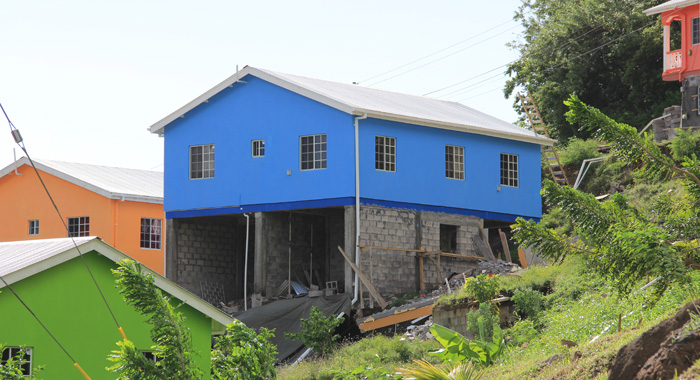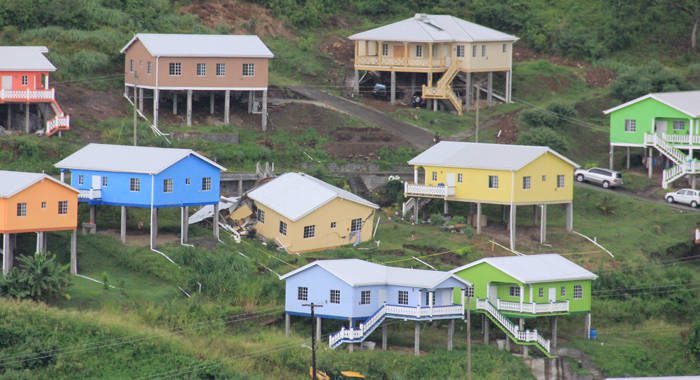The cause of collapse of a three-bedroom concrete house in the government’s housing estate at Clare Valley last September is inconclusive, the geologist that the government hired to conduct an investigation has found.
Richard Robertson, however, said that the collapse appears to be largely due to “insufficient consideration being given, in the construction of the building, to the nature of the earth materials (soils and underlying geology) that comprise the area”.
He also called for “a detailed investigation of the house that collapsed so as to better understand the load bearing capacity of the foundation and its interaction with the ground.
“The objective should be to obtain knowledge that may be applied to other similar structures in the area,” he said.
The state-owned Housing and Land Development Corporation (HLDC) built the houses as part of the government’s low- and middle-income housing initiative.
Related:
- ‘Somebody is short of criminal liability’ in Clare Valley housing fiasco — MP
- Clare Valley homeowners were banned from visiting during construction (+Video)
- Gov’t to demolish house in Clare Valley
- Homeowner pleased with remedial work in Clare Valley
Robertson said in his report that it was “not clear that full consideration was taken of the basic geology of the area or of the specific nature of the soil materials comprising the valley”.
The house collapsed on a raining Sept. 19, days after its owner filed with the HLDC another report that the building was shaking.
The contractor who built the house has accused the HLDC official who supervised the construction of not supplying the tool needed to dig a proper foundation, an accusation that the HLDC official has declined to comment on.
The contractor has also said he believes that other houses near to the one that collapsed could suffer a similar fate.
A house in that stretch is still standing, months after it was identified for demolition, the HLDC having lost a battle against the rain to shore up its foundation.
Robertson’s findings are contained in a report he submitted to the government last year after visiting the site on Oct. 29.
The Office of the Prime Minister circulated the report to the media this week, months after the government commenced work to stabilise several of the houses and construct drains.
Robertson said in his report that the site conditions are “challenging in terms of the establishment of firm bedrock for construction purposes, but are not significantly different from other areas on the island where housing has successfully been established.
“The nature of the earth materials is such that the main contributors to slope instability are slow downslope movement of the coherent lava blocks driven by a combination of gradient flow and underground pore water pressures,” he said.
He said construction of houses have resulted in a net increase in the stress on the soil mass.
“In order to assess the bearing capacity of foundations, compressibility of the soils in the area, the stability of embankments created and the lateral pressure on earth-retaining structures, it should have been necessary for engineers to know the nature of the distribution of stress along a given cross section of the soil profile.”
He said officials should have had “some understanding of the fraction of the normal stress at a given depth in the soil mass that is carried by water in the void spaces versus the fraction carried by the soil particles themselves i.e. the soil skeleton.
“It is not clear that this information was available or considered in the design and construction of houses in the area investigated. It is also not clear that full consideration was taken of the basic geology of the area or of the specific nature of the soil materials comprising the valley,” he further said.

Robertson said a detailed analysis of the vertical stress in soil that would have occurred as a result of foundation construction is “outside the remit of this investigation and so it cannot be verified that the direct cause of the collapse was due to an increase in vertical stress.
“However, if sufficient account was not taken of the inhomogeneity of the earth materials upon which foundations were constructed, then subsequent differential settlement and compaction would have resulted in increased stresses on columns, resulting in shear failure and collapse,” Robertson wrote.
He, however, concluded that safe construction should be possible in this area “as long as adequate account is taken of the site conditions”.
“Urgent remedial work is needed in order to stabilize steep slopes created during construction and to deal with surface run-off from buildings and roadways so as to minimise the erosive impact of water,” he said.
During his investigation, Robertson visited the site of two building that were being constructed in the housing estate.
“It was noted that excavations, which appear to be intended for soakaways, had been made at the lower end of the houses, within one foot of the foundation columns.
“Although the author is not a civil engineer, the excavations weakens the load bearing capacity of the soil and provides access for underground water. This could compromise the stability of the foundation columns in the immediate vicinity and also promote slope instability.
“Minimal provisions appear to have been made for all types of surface runoff in the area. Given that the removal of vegetation for housing would have compromised natural drainage mechanisms, it is expected that there would have been increased surface runoff in the entire area,” Robertson said.
Robertson also said that in order to minimise the risk of slope failure or further collapse of structures, the structural integrity of each building in the area needs to be re-examined, particularly the ones in which there has been reported unusual vibrations or where there are significant drainage problems.
“Earth retention structures need to be designed and constructed to strengthen the unrestrained and steep slopes created in the area by house construction. Some of these measure may include soft solutions such as sediment traps and the planting of vegetation as has already been applied in some parts of the development.
“Drainage in the entire area needs to be re- examined and measures implemented to adequately cater for surface run-off from buildings so as to minimise the erosive impact of the water and also its potential to change underground water conditions such that it leads to mass movement downslope,” he further said.







What is now needed is an impartial assessment by a structural engineer.
Quite right David, they certainly need another expert opinion from an expert in structure in suspect soild.
I wrote a piece with the name and adress of a UK firm that specialize in exactly this sitiuation.
They are also experts in building airport runways on suspect soils. They ignored that and brought in their choice of man.
They do not want a wrong answer even if its the right answer.